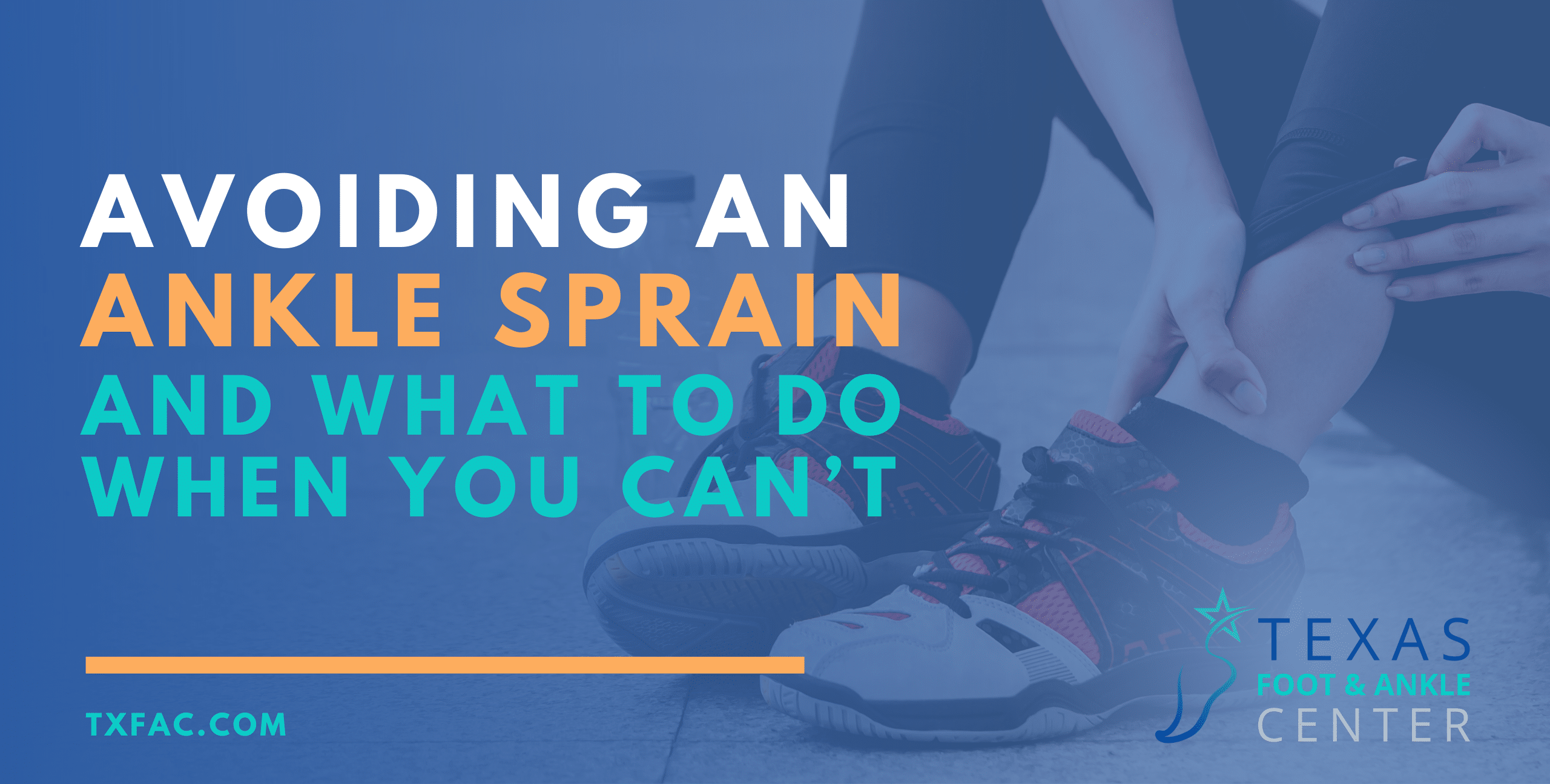An all-too-common injury, ankle sprains can happen to anyone. And while they may cause physical discomfort and inconvenience, there’s good news! By learning how sprains occur and how to avoid them, you can stay ahead of the game and keep your feet feeling fantastic.
In fact, reducing both the frequency and severity of sprains is extremely important if you want to prevent potential long-term consequences. This includes knowing how to reduce your personal risks and properly treat an ankle sprain if and when one does occur.
Sprains are not trivial injuries. Even one or two “minor” ones can lead to chronic pain and instability if you don’t seek proper care.
So don’t let an ankle sprain catch you off guard! In today’s blog post, we’ll show you how to approach any activity or sport with confidence, knowing that your ankles are well protected.
What is an Ankle Sprain?
Before we discuss how to avoid ankle sprains, it’s crucial to understand what they are and what causes them. Ankle sprains happen when the ligaments that connect the bones of the ankle joint are stretched or torn due to excessive force. This can happen during physical activities that involve sudden twisting or turning of the foot, such as playing sports, stepping off a curb, or simply walking on uneven surfaces.
How to Avoid an Ankle Sprain
Now that you know what an ankle sprain is, let’s talk about how to avoid it. Here are some fun and easy tips to keep your ankles happy and healthy:
Warm-up and Start Slow
Before starting any physical activity, take a few minutes to warm up your muscles and joints. This can include stretching or simple exercises like calf raises or leg swings. Not only will this help prevent injury, but it will also get your body ready to perform at its best.
And if you are just starting a new activity or sport, head into it cautiously and gradually work your intensity up. Going full bore into exercises that your body is not conditioned to handle is a ticket to injury—especially sprains.
Wear Proper and Stable Shoes
Many people will go straight to high heels when they think of shoe types that cause ankle sprains. They are certainly a top offender but by no means the only ones!
A shoe can have a low heel, but can still increase your risk of a sprain if it has low lateral stability for your needs. In other words, it is not keeping the side-to-side movement of your foot stable, making it more likely that you may roll your ankle with a misstep.
Worn-out shoes have lost much of this stability, and flip-flops and sandals can barely have any to begin with. But it’s important to ensure even relatively new shoes are best built for the demands you wish to put them through.
The right shoes will make all the difference in preventing ankle sprains. Search for shoes that fit well and provide adequate support for your feet and ankles. When playing sports with frequent lateral movements, like tennis or basketball, make sure you are wearing tennis or basketball shoes built to increase lateral stability.
And don’t be afraid to add a little color or style to your footwear to keep things fun!
Replace Old Shoes
Just like clothes, shoes have a shelf life. As your shoes age, they lose their ability to support and cushion your feet, making you more susceptible to injury. Replace your athletic shoes every six months or sooner if you’re a frequent runner or athlete.
Wear Tape or a Supportive Brace
If you have a history of repeated ankle injuries or want extra support during physical activity, consider wearing a brace or taping your ankle. Not only will this help prevent harm, but it can also give you the confidence to take on more challenging activities.
Avoid Uneven Surfaces
Walking or running on uneven surfaces can increase your risk of an ankle sprain. Keep an eye out for cracks, holes, and loose gravel. If you can’t avoid an uneven surface, take it slow and pay close attention to your footing.
Do Ankle Exercises for Balance, Strength, and Stability
The difference between a simple stumble and a painful sprain often depends on how well you can correct yourself after you start to lose your balance. The better you condition your ankle strength and sense of balance, the better you can respond to unstable situations—and have a better outcome.
Since strong ankles are less prone to injury, try adding some ankle exercises to your routine to help build up your muscles and ligaments. Some exercises that could help include:
- Ankle circles: Sit with your legs outstretched and rotate your ankles in a circular motion.
- “Write” with your foot: While sitting, extend one leg out in front of you. Treating your big toe as a pen, move your ankle to write out the alphabet in the air. Repeat 2-3 times with each foot.
- Heel lifts: Stand with your feet hip-width apart and rise up onto your toes, then lower back down. Repeat ten times.
- Toe flexion with resistance band: Sit on the floor with a resistance band looped around the ball of your foot. Flex your foot back towards your body, then release. Repeat ten times on each foot.
- Balance exercises: Stand on one foot for as long as possible, then switch to the other foot. If you have trouble balancing, start with shorter durations and work your way up.
These are basic exercises to start. We can help you determine more advanced and targeted routines for your individual needs if you wish.
Know the First Steps to Take if You Suffer a Sprain
With ankle sprains, proper treatment is an important step toward preventing future sprains.
When a sprain does not heal properly, it can cause weakness and instability in the ankle which increases the probability of another sprain, which increases the chance of another, and so on. The right treatment can break that downward spiral, and it begins as soon as you start feeling pain.
Stop and Get Your Ankle Evaluated
Immediately stop what you’re doing if you can. No trying to “walk it off.” No “pushing through.” If the ligaments in your ankle have been strained or torn, trying to continue will only put them at risk for further damage.
Take the weight off the affected foot as soon as possible and give us a call, even if you feel the sprain is mild. Many supposedly “mild” ankle sprains that should receive professional treatment go unreported, and this greatly increases the risk of chronic problems. If your symptoms sound mild, we may ask you to simply keep an eye on things, and we will have a record of the injury in case additional problems arise in the future.
RICE
Follow RICE therapy through the first 48 hours to help reduce pain and swelling.
- Rest: Continue to keep weight off the injured ankle.
- Ice: Apply an ice pack (a bag of frozen veggies will also do) to the area for 15-20 minutes, every 2-3 hours. Wrap your ice pack in a thin towel to stop it from damaging your skin.
- Compression: Wrap the ankle in an elastic medical bandage, making it snug without constricting your blood flow. Loosen the bandage if the area below the wrap feels cold, numb, or tingly.
- Elevation: Keep your ankle above the level of your heart as often as possible. This can be as simple as propping your leg up on pillows while resting on the sofa or in bed.
Stay Sprain-Free with Texas Foot & Ankle Center!
If you experience an ankle sprain, don’t let it keep you down! Contact your friendly experts at Texas Foot & Ankle Center for diagnosis and treatment. Our team of podiatrists will help get you back on your feet and ready to tackle any activity with confidence.
Ankle sprains can happen to anyone, but you can help prevent them with just a bit of know-how. Keep your ankles happy by warming up, wearing proper footwear, doing ankle exercises, and avoiding uneven surfaces.
And remember, if you do experience an ankle sprain, don’t let it hold you back—contact Texas Foot & Ankle Center to schedule an appointment today and get back in the game!


